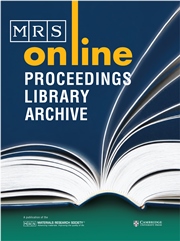Article contents
Demonstration of the Bacterial-Biomaterial Interface in Implant Specimens
Published online by Cambridge University Press: 26 February 2011
Abstract
Bacterial infection can be a problem associated with biomaterial implants especially with the total artificial heart or other cardiovascular prostheses such as ventricular assist devices, intravenous catheters, ventriculo-atrial shunts, pacemaker electrodes and, rarely, prosthetic heart valves. Bacterial commensals such as Staphylococcus epidermidis, which is ordinarily non-infective in human skin and mucous membranes, is now recognized as an opportunistic pathogen of biomaterial implants, particularly cardiovascular prostheses. In these implantations the S. epidermidis undergoes transformation to produce mucoid or polysaccharide extracellular coating substances. The latter promote bacterial adherence to biomaterial surfaces and protect the bacteria to some extent against antibiotics and host defense mechanisms. The result is increased virulence of the slime-producing strains. A number of techniques have been developed in our laboratories which facilitate identification of such bacterial pathogens on biopsy or postmortem specimens. These light and analytical electron microscopic methodologies include special cytochemical staining and rapid drying and embedding methods. Their efficacy and accuracy have been verified by studies on cultured and subcultured pathogens which are more time consuming. It is of interest that the microscopic methods showed the presence of macrophages as well as neutrophils on the specimens.
Information
- Type
- Research Article
- Information
- Copyright
- Copyright © Materials Research Society 1988
References
- 2
- Cited by

